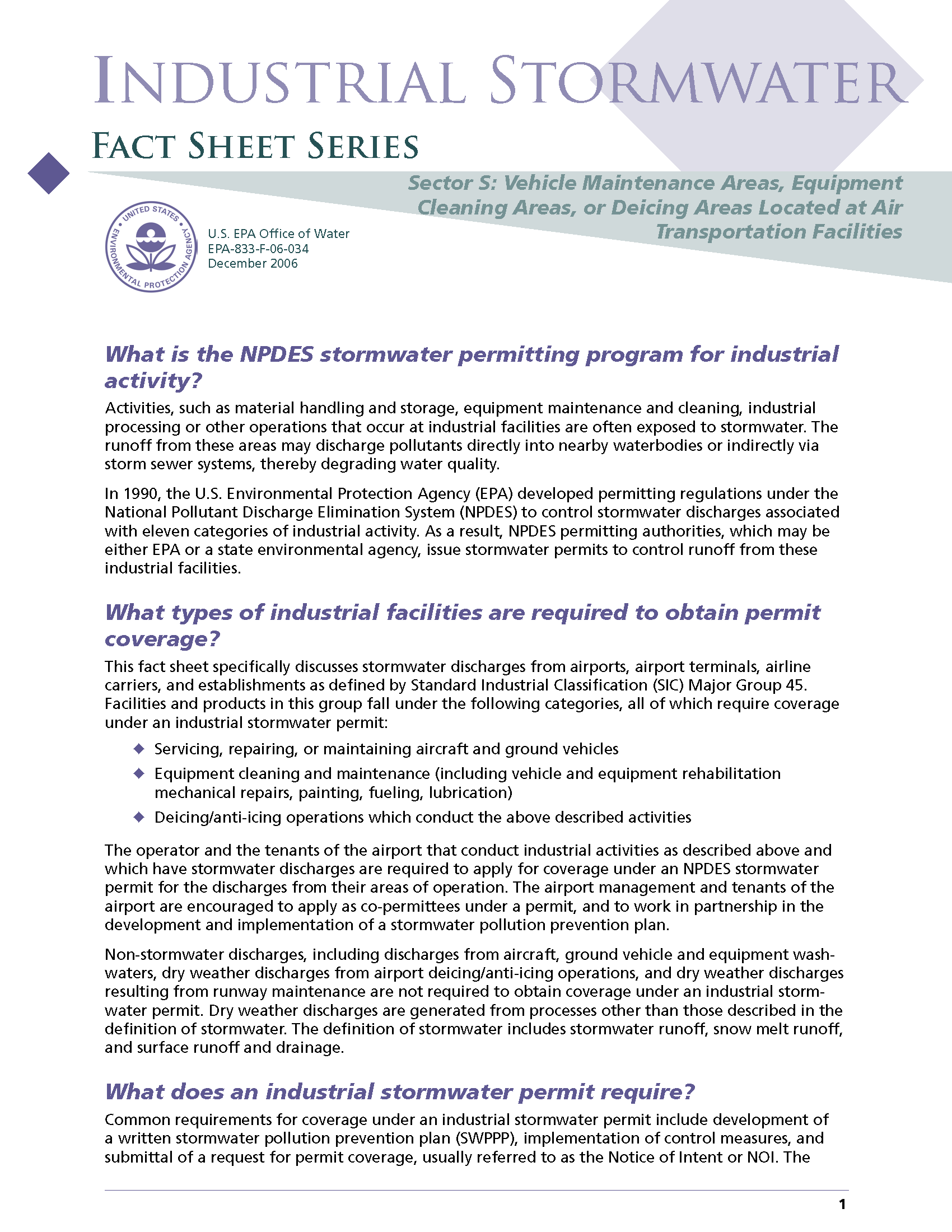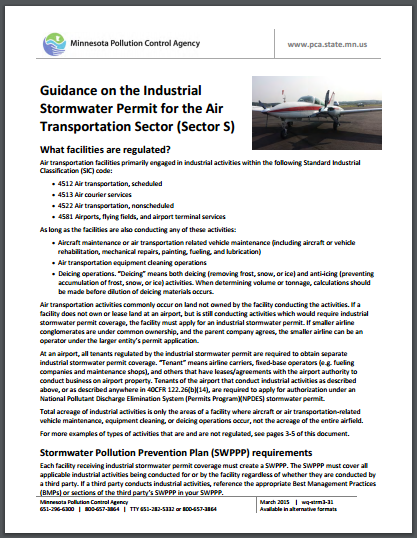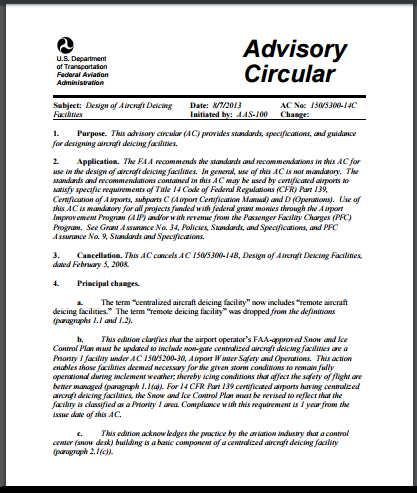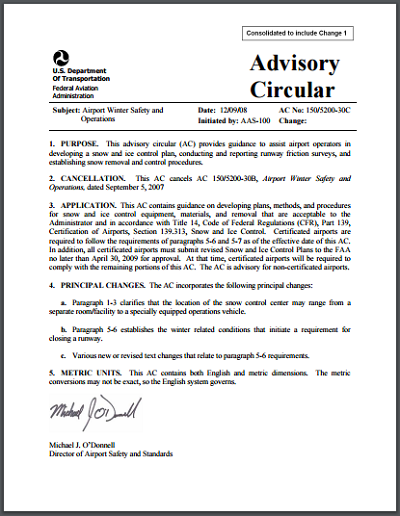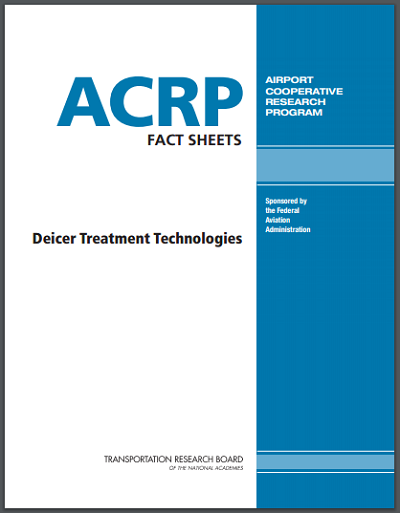< Return to Stormwater Regulations & Permitting
Regulatory Summary: Deicing Stormwater Permitting
The discharge of runoff from aircraft and airfield pavement deicing operations is unique to airports and is often the single greatest stormwater management concern to regulators when issuing a stormwater permit to an airport.
Why are stormwater discharges containing runoff from deicing activities a special regulatory concern and challenge?
Environmental regulatory concern over airport deicing is based on a number of factors. First, all deicers that are certified and approved for use on aircraft or airfield pavement have potentially significant environmental characteristics. Typically, the dominant concern is that these deicers are readily biodegradable and large amounts of deicers in discharges could present a risk for reduced dissolved oxygen in downstream surface waters if oxygen is consumed by biodegradation faster than it can be replenished by reaeration processes. There are also potential concerns about aquatic toxicity associated with certain additives in the deicers.
Related to the environmental characteristics of deicers is the magnitude and intensity of their use at large busy airports. Hundreds of thousands, or even millions of gallons of aircraft deicers may be used at the largest hub airports during a severe winter season.
Finally, the deposition of spent deicers from deicing operations is inherently diffuse. Deicing is conducted at locations across the airfield, often under severe winter storm conditions of high winds and heavy precipitation, with complex fate and distribution pathways. As a result, controlling the impacts of deicing operations on airport stormwater is especially challenging, and never 100 percent effective.
What are the most likely pollutants resulting from airport deicing activities?
Aircraft deicers are formulated products containing a freezing point depressant, typically either propylene or ethylene glycol, water, and a small amount of an additive package (“AdPack”) required for performance certification. The components of the AdPack typically include surfactants, corrosion inhibitors, thickeners, and dyes. The concern with the use of glycol-based deicers generally is that they exert high oxygen demands when released into receiving waters. There are also potential concerns associated with aquatic toxicity contributed by the AdPack.
ACRP Web-Only Document 3: Formulations for Aircraft and Airfield Deicing and Anti-icing: Aquatic Toxicity and Biochemical Oxygen Demand provides comprehensive information on the composition of aircraft and airfield deicers and their environmental implications.
Airfield pavement deicers are available in both liquid and solid forms. All are composed of a freezing point depressant and a small amount of corrosion inhibitor. The liquid pavement deicers also contain water. There are a wider variety of freezing point depressants used in pavement deicers, including various glycols, potassium acetate, potassium formate, sodium acetate, sodium formate, and urea. The environmental concerns are similar to the aircraft deicers.
How are stormwater discharges containing runoff from deicing activities permitted?
Deicing is one of the categories of “industrial activity” that are covered under the industrial stormwater regulations. As such, discharges associated with these activities are authorized either under the applicable General Industrial Stormwater Permit or an Individual Stormwater Permit. Generally, larger airports with significant deicing operations will be required to obtain an individual permit. The justification is that the requirements in a general permit will not provide adequate protection of receiving waters in light of the magnitude of deicer usage. Stormwater discharges containing deicers at most smaller northern tier airports, or airports in southern regions where deicing activities are limited, will typically be covered by a general industrial stormwater permit.
What special considerations are needed in permitting stormwater discharges containing runoff from deicing activities?
A number of issues can come up during the process of obtaining or renewing a National Pollutant Discharge Elimination System permit for discharge of stormwater containing deicers. It’s important for an airport going through a new permitting or renewal process to be aware of these issues so they can be appropriately considered.
The first issue is that of potential misinterpretation of the applicable Clean Water Act regulations. This can take the form of inappropriate application of technology-based effluent limits from other types of discharges, or misapplication of EPA’s Effluent Limitations Guidelines and New Source Performance Standards for the airport deicing category. As an example of the latter, a key consideration is that collection performance standards only apply to new airports, and not new facilities at existing airports.
Misunderstanding the nature of deicing operations and the products used can lead to permit requirements that are inappropriate, or difficult or even impossible to meet. The technology of deicing is constantly evolving, and obsolete information remaining on the internet can confuse the understanding a complicated and somewhat arcane topic. For this reason, it’s usually worth the effort for an airport to educate regulatory staff about how deicing is conducted; the regulations regarding which products can be used; the environmental characteristics of those products; and feasible options for source reductions, collection, and disposal or recycling.
ACRP has published a variety of guidance documents dealing with different aspects of airport deicing. These and other relevant documents can be found in the Airport Stormwater Management Library by searching on these keywords: deicing deicers.
The risk of water quality impacts posed by airport deicing discharges is mitigated by a number of factors that are unique to these discharges, and often unrecognized by regulators. While deicing discharges occur during periods of elevated stream flow and low temperatures, water quality models used by regulatory agencies are generally configured to represent water quality processes under very low stream flow and the warmest times of the year. Extrapolation to wintertime temperatures and stream flows without appropriate adjustments to the calculations can significantly overstate the impact of deicers.
* * * * * * *


